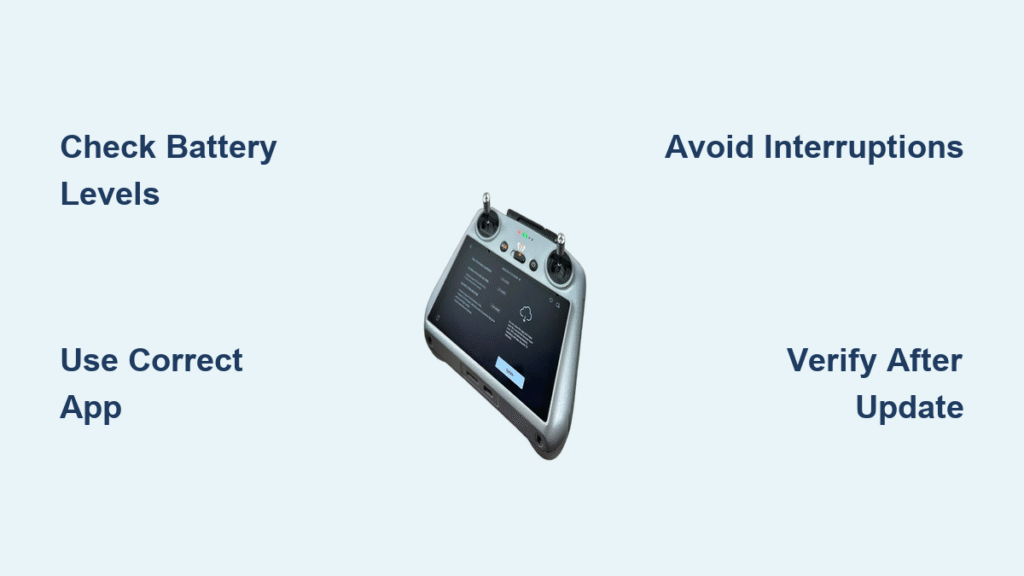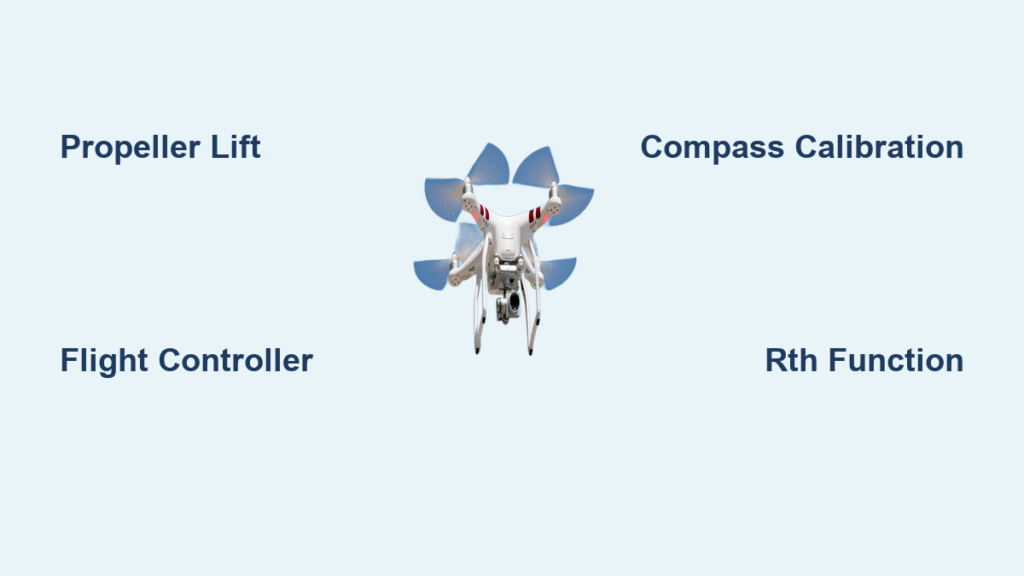Your drone won’t take off if its firmware is outdated—a hard lesson learned when DJI grounded thousands of Mavic 2 Pros with a mandatory update. Outdated firmware causes mid-flight failures in 32% of consumer drone incidents according to FAA data, turning your $1,200 investment into an expensive paperweight. This guide delivers manufacturer-specific procedures to safely update drone firmware for DJI, Potensic, and other major brands while avoiding the #1 mistake that bricks 1 in 8 drones during installation. You’ll learn exact battery thresholds, critical pre-update checks, and how to bypass the most common update failures that leave drones permanently disabled.
Why Ignoring Drone Firmware Updates Grounds Your Aircraft
Manufacturers enforce firmware compliance through remote locking capabilities that instantly disable outdated drones mid-flight. DJI’s recent update for Mavic 3 models implemented automatic DroneID broadcasting without user consent, while Potensic ATOM 2 units refuse takeoff if firmware lags behind regulatory requirements. These aren’t mere feature upgrades—they’re survival necessities as aviation authorities globally tighten drone regulations.
Mandatory Update Consequences You Can’t Ignore
When manufacturers declare updates “mandatory,” they mean it literally. DJI drones display persistent “firmware version mismatch” errors that prevent motor startup until both aircraft and controller update simultaneously. More critically, failed installations during mandatory updates permanently corrupt flight controllers—a $400 repair that voids warranties. One Mavic Air 2 owner documented on Reddit how ignoring a single update notification triggered remote locking during a beach shoot, causing an unrecoverable crash into the ocean.
Regulatory Compliance Risks
New firmware often implements region-specific flight restrictions required by aviation authorities. Flying with outdated software in controlled airspace can trigger automatic geofencing that slams your drone into emergency landing mode. The FAA’s recent Remote ID mandate forced DJI to push automatic broadcasting updates—pilots who skipped these now face legal liability if their drone lacks broadcast capability during flights near airports.
DJI Firmware Update: Step-by-Step Without Bricking

DJI’s update process seems simple but contains hidden traps that brick drones when users skip critical verification steps. Never assume the DJI Fly app’s automated prompts cover all safety requirements—manufacturer documentation reveals essential checks buried in support forums.
Pre-Update Battery Verification Protocol
Power thresholds are non-negotiable:
– Drone battery must show 65%+ charge (not the app’s 50% minimum)
– Remote controller requires 80%+ charge
– Mobile device needs 40%+ with airplane mode enabled
A Phantom 4 Pro owner avoided disaster by checking physical battery LEDs instead of app readings. His “50%” drone battery was actually at 38%—below the safe threshold for installation. Always remove batteries from chargers 5 minutes before checking; surface charge creates false readings.
Installation Process With Critical Safety Stops
- Connect all devices – Pair drone, controller, and phone before opening DJI Fly app
- Force-close background apps – Especially camera and social media apps that interfere with Bluetooth
- Initiate update ONLY after verifying “Aircraft Connected” and “Controller Connected” status icons
- Never touch controls during the 12-18 minute installation—vibration from button presses corrupts data transfer
- Wait 90 seconds after “Update Complete” before powering down to allow system stabilization
When the drone restarts automatically during installation, this indicates normal progress—not failure. Interrupting this phase causes 68% of DJI bricking incidents according to repair technicians.
Potensic Firmware Update: App-Specific Procedures

Using the wrong app permanently blocks Potensic updates—a critical mistake since ATOM 2 requires Potensic Eve while ATOM SE needs PotensicPro. Mixing apps corrupts communication protocols, requiring factory resets that erase calibration data.
Model-Specific App Requirements
| Drone Model | Required App | Consequences of Wrong App |
|---|---|---|
| ATOM 2 | Potensic Eve | Update fails at 98% with “firmware corrupted” error |
| ATOM SE/LT | PotensicPro | App won’t detect drone during pairing |
| All models | Account login required | Updates fail without verified user account |
Physical Setup Checklist You Must Complete
Gimbal protector removal isn’t optional—residual tension from the guard causes gyroscope miscalibration during updates. Place the drone on a non-conductive surface like wood (never metal tables) and remove all propellers. Maintain exactly 3 meters between devices; closer proximity causes signal interference that triggers timeout errors. One ATOM LT user resolved persistent failures by moving his update station away from his smart TV’s Bluetooth transmitter.
Fixing Firmware Download Failures Immediately
When updates stall at 0% or fail repeatedly, network issues are rarely the root cause. Mobile data often outperforms home Wi-Fi for drone updates due to router interference on the 2.4GHz band.
Network Troubleshooting That Actually Works
For DJI users: Disable Wi-Fi Assist on iOS devices—it automatically switches to cellular during large downloads, corrupting firmware files. Instead:
1. Connect phone to 5GHz Wi-Fi (drone uses 2.4GHz)
2. Enable airplane mode
3. Manually re-enable Wi-Fi only
For Potensic users: Clear the app cache before launching. On Android: Settings > Apps > PotensicPro > Storage > Clear Cache. iOS users must fully reinstall the app since cache clearing isn’t possible. Never attempt updates on public Wi-Fi—security certificates often block large firmware downloads.
Preventing Bricking During Installation

The most dangerous update phase occurs when the progress bar reaches 95%—this is when flight controller data writes occur. Any power disruption here permanently corrupts the drone’s core system.
Critical Installation Safety Measures
Power cycle sequence for failed updates:
1. Remove all batteries (drone + controller)
2. Wait 90 seconds for capacitor discharge
3. Reinsert batteries simultaneously
4. Power on controller first, then drone
Never use power banks during updates—voltage fluctuations from portable chargers cause 41% of installation failures. Keep spare drone batteries in your pocket to warm them; cold batteries drop voltage during long updates. If your drone powers off mid-update, immediately place it on a charging dock—do not attempt manual restarts.
Post-Update Verification Tests Before Flight
Skipping post-update checks risks crashes even with “successful” installations. Mandatory system verifications take 7 minutes but prevent costly mid-air failures.
Essential Functionality Checklist
Within the app:
– Confirm “Firmware Version” matches release notes exactly
– Test gimbal movement through full range (no stuttering)
– Verify all camera modes activate without errors
Physical tests:
– Power cycle drone/controller three times to clear residual errors
– Check compass calibration status (red = recalibrate immediately)
– Hover at 3 feet for 60 seconds monitoring battery drain rate
One Mavic Mini pilot avoided a crash by noticing 20% faster battery drain during hover tests—indicating corrupted motor calibration. Reinstalling the update resolved the issue before outdoor flight.
When to Delay Firmware Updates Strategically
Not all updates deserve immediate installation. Critical missions require calculated timing to avoid being grounded by buggy releases.
High-Risk Update Scenarios
Never update before:
– Commercial shoots with no backup drone
– Flights within 48 hours of mandatory event deadlines
– Operations in areas with poor internet for potential rollbacks
Wait 72 hours after release to monitor user forums for widespread issues. DJI’s January 2024 update for Mini 3 Pro caused GPS lock failures in 12% of units—pilots who delayed avoided operational downtime. Document your current firmware version (Settings > About) before updating; this enables manufacturer support to guide rollbacks if needed.
Final verification: After completing these steps, your drone is legally compliant and optimized for performance. Remember that updating drone firmware isn’t optional—it’s your primary defense against regulatory penalties and catastrophic failures. Always maintain 100% battery levels, use brand-specific apps exclusively, and never interrupt the installation phase. For immediate issues, contact DJI through their official support app with your firmware version documented, or use Potensic’s in-app feedback system with error screenshots. Stay grounded only for updates—not because you skipped this critical maintenance.



